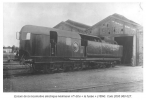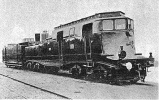Gloster
Established Member
I will pass on this one. (I had been wondering if Brayton was a corruption of Brighton, or hoping that there were more places called Papcastle.)
I will pass on this one.
(I had been wondering if Brayton was a corruption of Brighton, or hoping that there were more places called Papcastle.)
Not that. It was more fundamental.Something to do with bogies that could move?
No. It was a new concept of locomotive.Turnouts?
Not that. I think Locomotion No 1 in 1825 had coupling rods. A clue - M. Heilmann came up with his idea in the 1890s. What technology was emerging at about that time which could be applied to locomotives?Coupling rods, so more than one axle could be driven?
Or electric-steam. Electric immersion heater used for raising steam instead of burning coal.Steam-electric locomotive engine?
That's the one. It's your floor but I couldn't resist doing a bit more research.Steam-electric locomotive engine?

THe locomotive was named Le Fus�e Electrique. (The Electric Rocket) a reference to Stephenson's Rocket.
Jean-Jacques Heilmann, proprietor of the Soci�t� Industrielle de Moteurs �lectriques et � Vapeur in Le Havre, took out his patent for a steam-electric locomotive on July 18, 1890, and the first prototype was built in 1892-93. Heilmann and his coworker Drouin began with static tests to determine whether DC or the recently introduced 3-phase AC would be most suitable for their purposes. It was quickly found that DC would be best, as it allowed the steam-engine and generator to work at a constant efficient speed, while the traction motor speed could be quite different. The chassis of Le Fusee was 16.3 m long overall, mounted on two 4-axle bogies. Each axle was driven by a 60 hp electric motor. The total weight was 110 tons. Electricity was generated by a 400 kW generator, driven by a horizontally-opposed two-cylinder steam engine. The field current for the generator was supplied by a small vertical steam engine driving a dynamo

Two new locomotives were built, numbered 8001 and 8002, of more advanced design.
The improved design used a conventional Belpaire boiler without superheater and a much more powerful Willans high-speed vertical steam engine to drive the DC generators. 1000 kW of mechanical power was produced at 400 rpm, and each six-pole generator gave 450V at 910A, or 410 kW each. The generators could sustain a 100% overload for 15 minutes, and a 50% overload for 30 minutes. The exciter dynamo was driven by a small-cylinder engine developing 18 kW at 550 rpm; the exciting voltage was 110V and 140A was available. Only 100A was required for excitation of the main generators, the surplus being used for lighting. The electrical equipment was once again supplied by Brown Boveri & Co.
The first of the two machines made its initial test run of 115 km on 12 November 1897. The load consisted of 12 personnel and a test van, giving a total weight of 150 tonnes, and the maximum speed was restricted to 30 km/h. These tests were completed without difficulties. On later test runs the total weight was increased to 250 tonnes and speeds increased to 100km/h. The maximum speed attained was 120 km/h. The two big Heilmann locomotives clearly showed their advantages over the classical steam locomotive. The total weight was usable for the adhesion and the design gave good acceleration and traction power as well as outstandingly quiet running over the whole speed range.
No, the point is ingeniously modified so it is smaller while being transported. But how?For the third: does the point stick out of the bottom of the wagon?
No, these are the standard turnouts like in those lovely photos of the station throat at Frankfurt/M. Taking them at 190 kmh would be disastrous and hopefully impossible. The permitted speed would be quite high on a bicycle though.Is the clue in the question?
Type 190: 190 km/hour
Otherwise, I have no idea so would just be coming out with random numbers, which feels a bit pointless (pun intended!).
Answers:Very good, it could have revolutionised rail travel had things gone a bit differently, who knows?
..
How many thousand points and crossings are there on the DB network in Germany?
The most numerous turnouts are type 190, what does the number signify, how fast may they be taken?
Points can be transported on special wagons, suspended at about 45° (the wagons are unfortunately scarce). The DB point works found a way to make points that could fit in the loading gauge on standard flat wagons, what was the modification?
The fastest turnout in the world (going straight ahead) is in France. What was the maximum speed of a train traversing it?
I bet I am not the only one here who loves pictures of trackwork without trains.
None.
The answer lies somewhere between these two!All?
Three is the correct answer, and bonus points for the extra gen.Three: E3002 and E3019 were damaged beyond repair in fires and E3009 was wrecked in the Hixon crash in January 1968.
